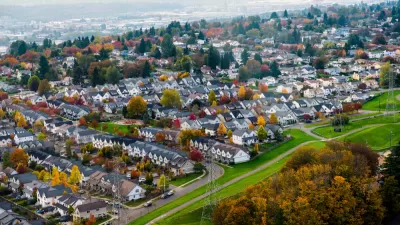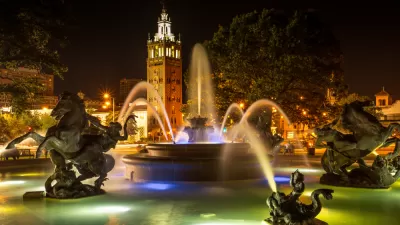On the sixty-year anniversary of the genesis of the country's first enclosed mall, Mark Hinshaw looks at America's foolish detour into shopping malls.
In the six decades since Victor Gruen published his shopping mall manifesto in Progressive Architecture magazine, "many hundreds of malls have been built on thousands of acres in virtually every part of the country" forever changing "how we travel, how we spend our leisure time, and how we spend our money," writes Hinshaw.
Perhaps more significant is the sprawling suburban land use model that the enclosed mall and its sea of parking helped facilitate, to the detriment of our traditional downtowns and main streets. Most ironically, as Hinshaw notes, "Gruen saw his model as saving cities and towns, instead of draining their downtowns of life, though that's what happened more often than not."
Hinshaw relishes the fact that the enclosed mall era seems to be coming to an end nationwide. In his own region, this trend is evidenced in the fact that, "Here in Puget Sound, the last regional mall built was Silverdale, almost 20 years ago - even though the central Puget Sound population has grown by more than 2 million people in that same time!"
Hinshaw concludes his article with a look at the future that might have been, as demonstrated by a far different model of retail development pioneered earlier in the last century by Jessie Clyde ("J.C.") Nichols at Country Club Plaza in Kansas City, which still exists today.
"Known affectionately by locals as simply 'The Plaza,' it shines in its utter brilliance. Rather than the vast parking lots envisioned by Gruen in the 50s, Nichols placed all of the parking in multilevel garages, wrapped with small shops and whimsically-designed facades. Every single store, large or small, faces a street. Large trees and wide sidewalks, along with elegant light fixtures, faintly echo the grand boulevards of Paris."
FULL STORY: America's foolish detour into shopping malls

Alabama: Trump Terminates Settlements for Black Communities Harmed By Raw Sewage
Trump deemed the landmark civil rights agreement “illegal DEI and environmental justice policy.”

Planetizen Federal Action Tracker
A weekly monitor of how Trump’s orders and actions are impacting planners and planning in America.

The 120 Year Old Tiny Home Villages That Sheltered San Francisco’s Earthquake Refugees
More than a century ago, San Francisco mobilized to house thousands of residents displaced by the 1906 earthquake. Could their strategy offer a model for the present?

Indy Neighborhood Group Builds Temporary Multi-Use Path
Community members, aided in part by funding from the city, repurposed a vehicle lane to create a protected bike and pedestrian path for the summer season.

Congestion Pricing Drops Holland Tunnel Delays by 65 Percent
New York City’s contentious tolling program has yielded improved traffic and roughly $100 million in revenue for the MTA.

In Both Crashes and Crime, Public Transportation is Far Safer than Driving
Contrary to popular assumptions, public transportation has far lower crash and crime rates than automobile travel. For safer communities, improve and encourage transit travel.
Urban Design for Planners 1: Software Tools
This six-course series explores essential urban design concepts using open source software and equips planners with the tools they need to participate fully in the urban design process.
Planning for Universal Design
Learn the tools for implementing Universal Design in planning regulations.
Clanton & Associates, Inc.
Jessamine County Fiscal Court
Institute for Housing and Urban Development Studies (IHS)
City of Grandview
Harvard GSD Executive Education
Toledo-Lucas County Plan Commissions
Salt Lake City
NYU Wagner Graduate School of Public Service





























